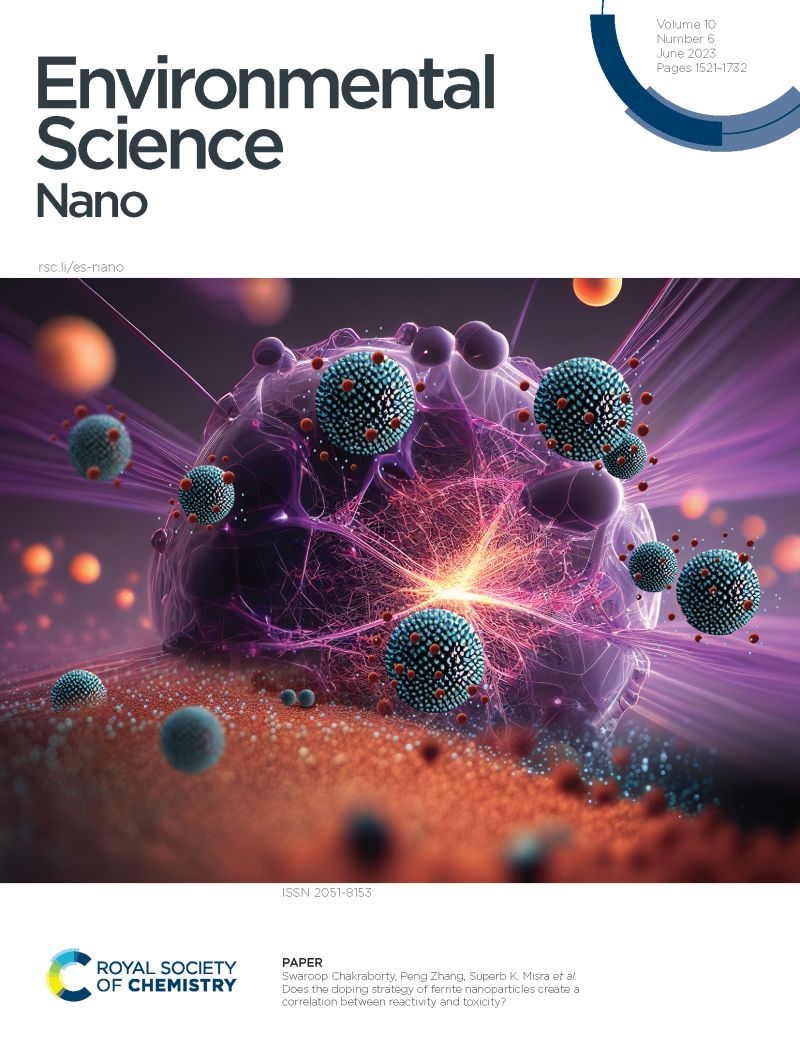Combating Eukaryotic and Prokaryotic Harmful Algal Blooms with Visible-Light Driven BiOBrxI1-x/MFe2O4/g-C3N4 (M = Co & Ni) Recyclable Photocatalysts
IF 5.8
2区 环境科学与生态学
Q1 CHEMISTRY, MULTIDISCIPLINARY
引用次数: 0
Abstract
Photocatalysis offers a promising avenue for completely mutilate harmful algal blooms (HABs), a significant threat to global freshwater reserves. In this study, a series of BiOBrxI1-x photocatalysts were synthesized and the most optimal catalyst was integrated with pristine g-C3N4 and pre-synthesized CoFe2O4/g-C3N4 and NiFe2O4/g-C3N4 to form binary and ternary composite heterojunction photocatalysts (BiOBr0.95I0.05/g-C3N4 - BG, CoFe2O4/BiOBr0.95I0.05/g-C3N4 - CBG, and NiFe2O4/BiOBr0.95I0.05/g-C3N4 - NBG). Synthesized photocatalysts were thoroughly characterized and their performance was evaluated through the visible light driven photocatalytic degradation of both Microcystis aeruginosa (prokaryotic) and Scenedesmus acuminatus (eukaryotic) algal cells sourced directly from ponds. Exceptional photocatalytic efficiency of CBG evidenced through the variation in chlorophyll-a content, malondialdehyde, and electrolytic leakage confirmed the complete rupture of the algal cells after 3 h of light exposure. This was further reconfirmed through fluorescent microscopy analysis and interestingly, both HABs failed to re-grow even after 10 days. Enhanced performance of CBG was attributed to the boosted generation of charge carriers facilitated by its extended visible light absorption, which in-turn produced reactive oxygen species (•O2- and •OH radicals) that caused irreparable oxidative damage to algal cells, while effectively suppressing the exciton pair recombination supported by its double Z-scheme heterojunction. Furthermore, magnetic recyclability feature of CBG facilitated their easy removal from treated water for avoiding secondary pollution. Design of magnetically recyclable photocatalysts for degrading both prokaryotic and eukaryotic HABs demonstrated here is anticipated to inspire the development of efficient photocatalysts and design cost-effective solutions required for treating ponds and lakes infected with HABs.利用可见光驱动的 BiOBrxI1-x/MFe2O4/g-C3N4(M = Co 和 Ni)可回收光催化剂抗击真核和原核有害藻类孳生
光催化为彻底消除对全球淡水储备构成重大威胁的有害藻华(HABs)提供了一条前景广阔的途径。本研究合成了一系列 BiOBrxI1-x 光催化剂,并将最优催化剂与原始 g-C3N4 以及预合成 CoFe2O4/g-C3N4 和 NiFe2O4/g-C3N4 集成,形成二元和三元复合异质结光催化剂(BiOBr0.95I0.05/g-C3N4 - BG、CoFe2O4/BiOBr0.95I0.05/g-C3N4 - CBG 和 NiFe2O4/BiOBr0.95I0.05/g-C3N4 - NBG)。对合成的光催化剂进行了全面的表征,并通过可见光驱动光催化降解直接取自池塘的铜绿微囊藻(原核)和尖尾藻(真核)藻类细胞对其性能进行了评估。通过叶绿素-a 含量、丙二醛和电解渗漏的变化,可以证明 CBG 的光催化效率极高,这也证实了藻细胞在光照 3 小时后完全破裂。荧光显微镜分析进一步证实了这一点,有趣的是,这两种 HAB 即使在 10 天后也未能重新生长。CBG 性能的增强归因于其扩展的可见光吸收促进了电荷载流子的产生,进而产生了活性氧(-O2- 和 -OH-自由基),对藻类细胞造成了不可修复的氧化损伤,同时在其双 Z 型异质结的支持下有效抑制了激子对重组。此外,CBG 的磁性可回收特性使其易于从处理过的水中清除,从而避免了二次污染。本文所展示的降解原核和真核有害藻华的磁性可回收光催化剂的设计,预计将激励高效光催化剂的开发,并设计出处理受有害藻华感染的池塘和湖泊所需的具有成本效益的解决方案。
本文章由计算机程序翻译,如有差异,请以英文原文为准。
求助全文
约1分钟内获得全文
求助全文
来源期刊

Environmental Science: Nano
CHEMISTRY, MULTIDISCIPLINARY-ENVIRONMENTAL SCIENCES
CiteScore
12.20
自引率
5.50%
发文量
290
审稿时长
2.1 months
期刊介绍:
Environmental Science: Nano serves as a comprehensive and high-impact peer-reviewed source of information on the design and demonstration of engineered nanomaterials for environment-based applications. It also covers the interactions between engineered, natural, and incidental nanomaterials with biological and environmental systems. This scope includes, but is not limited to, the following topic areas:
Novel nanomaterial-based applications for water, air, soil, food, and energy sustainability
Nanomaterial interactions with biological systems and nanotoxicology
Environmental fate, reactivity, and transformations of nanoscale materials
Nanoscale processes in the environment
Sustainable nanotechnology including rational nanomaterial design, life cycle assessment, risk/benefit analysis
 求助内容:
求助内容: 应助结果提醒方式:
应助结果提醒方式:


